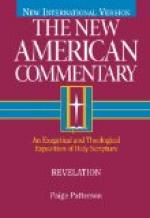The grand description of the process of resurrection follows the analogy of the order in the creation of man, giving, first, the shaping of the body, and afterwards the breathing into it of the breath which is life. Both stages are wholly God’s work. The prophet’s part was to prophesy to the bones first; and his word, in a sense, brought about the effect which it foretold, since his ministry was the most potent means of rekindling dying hopes, and bringing the disjecta membra of the nation together again. The vivid and gigantic imagination of the prophet gives a picture of the rushing together of the bones, which has no superior in any literature. He hears a noise, and sees a ‘shaking’ (by which is meant the motion of the bones to each other, rather than an ‘earthquake,’ as the Revised Version has it, which inserts a quite irrelevant detail), and the result of all is that the skeletons are complete. Then follows the gradual clothing with flesh. There they lie, a host of corpses.
The second stage is the quickening of these bodies with life, and here again Ezekiel, as God’s messenger, has power to bring about what he announces; for, at his command, the breath, or wind, or spirit, comes, and the stiff corpses spring to their feet, a mighty army. The explanation in the last verses of the text somewhat departs from the tenor of the vision by speaking of Israel as buried, but keeps to its substance, and point the despairing exiles to God as the source of national resurrection. But we must not force deeper meaning on Ezekiel’s words than they properly bear. The spirit promised in them is simply the source of life,—literally, of physical life; metaphorically, of national life. However that national restoration was connected with holiness, that does not enter into the prophet’s vision. Israel’s restoration to its land is all that Ezekiel meant by it. True, that restoration was to lead to clearer recognition by Israel of the name of Jehovah, and of all that it implied in him and demanded from them. But the proper scope of the vision is to assure despairing Israelites that God would quicken the apparently slain national life, and replace them in the land.
II. We may extend the application of the vision to the condition of humanity and the divine intervention which communicates life to a dead world, but must remember that no such meaning was in Ezekiel’s thoughts. The valley full of dry bones is but too correct a description of the aspect which a world ‘dead in trespasses and sins’ bears, when seen from the mountain-top by pure and heavenly eyes. The activities of godless lives mask the real spiritual death, which is the condition of every soul that is separate from God. Galvanised corpses may have muscular movements, but they are dead, notwithstanding their twitching. They that live without God are dead while they live.




